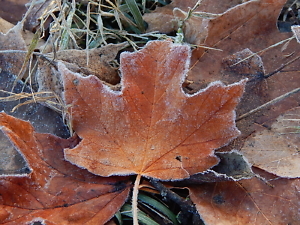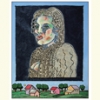Winter Solstice
December light is the sun with a migraine
Last night’s storm blew the trashcans over and whipped our neighbor’s pine cones along the sidewalk and street. This morning we opened the front door to walk the dog but stopped to breathe the cold slap of white pine.

I tried to make a bonfire to welcome the sun. All the wood and kindling are soaked from days of rain, but I did warm two pilfered pinecones to the smoking point. It’ll have to do. I was happy to inhale even this bit of pagan spark and heat at high noon (or low noon, given the date). The smoke snaked up over Next Door’s privacy fence as if it couldn’t get away fast enough.
That’s when peripheral vision told me I wasn’t alone. The ground was bubbling, somehow. It was erupting. Sugar maple leaves seemed to be hoisting themselves from our yard in somersaults: dozens of them, here, there. Every flip whispered: pshh, pshh in surround sound. When I focused on one pshh at a time, I saw the robins, at least forty of them, and the nearest was only a few feet away. Each one was shoveling leaves with its head. Scoop, pause, scoop, pause, repeat. Not that I was surprised to see robins in late December or even so many at once. Some robins migrate to Nashville, some migrate from Nashville, some just stay, and whoever happens to be here tends to hang out together.
What surprised me was how I didn’t notice I was mid-flock while I walked from the house with my matchbox and while I struggled with my pinecones. Today, the winter solstice, when most leaves are down, robins are camouflaged in space and time. They match the yard. Those wide breasts are sugar maple leaves: the male’s rust is the upper-leaf surface, the female’s peach is the lower. Gray-brown wings and heads are old elm leaves, hackberry leaves, as well as the mud scrapes where our dog’s feet have uprooted even the crabgrass. Oblique sun mosaics all these colors in glare and glow and shadow. Winter light is crooked. Winter light is the sun with a migraine. No wonder I needed a double take.
The robins do not mind me.
What are they searching for? Robins don’t want my black oil sunflower offerings by the birdbath; they eat invertebrates and fruit. Most insects are dead or underground by now. Winter ants should be active (I discovered these last December), but I haven’t checked. There may be the odd grass spider or thawed woolly worm, and last week I did hear a field cricket at dusk. The obvious plenty here is fruit: hackberry drupes are everywhere, having been blown or nudged from the five mature trees that hug the yard. But if the robins fancy a hackberry all-you-can-eat buffet they have only to walk or hop—because unlike some birds they can do both—a few feet to the driveway, where hundreds of sweet, garnet-colored BBs roll free, with no masking mat of leaves. No need for shovels.

Maybe even robins don’t see what is in front of them sometimes. Not when the sun has a migraine.
Actually, they would have to share the driveway hackberries with our dog and with me. Hackberries eat sweet and deep, though the flesh is no thicker than construction paper. Several foraging books say they taste like dates. They do, a bit, but you have to work for it. Pop a fat, smooth hackberry “berry” in your mouth, roll it between teeth and tongue and suck pumpkin-colored meat from bony pit. Spit the pit in weeds where a baby hackberry can sprout in spring to host three species of butterfly eggs laid singly in tiny leaf axils. Or spit the pit into your hand to admire wrinkles on a brain the size of a peppercorn. If your teeth are up to it, crack the brain and taste the soft kernel inside—green, but far paler than the two seed-leaves it was hoping to sprout later. I don’t recommend pliers, because they crush the whole thing flat.
Our dog doesn’t go to all this trouble. Beatrice swallows drupes without chewing, which is what the robins do. Last year, my husband took a photo of me in the driveway with Bea, where she and I both gobbled hackberries from the asphalt. I was squatting in my thickest parka plucking drupes one at a time with an ungloved pincer grip. And because it is a rare thing to be eating the same thing at the same time and off the same ground with one’s dog, every so often I would center one hackberry in my bare palm and offer it to her. She’d stop foraging and turn to me and kiss her whiskered chin to my skin and make the hackberry disappear. I love the soft sound of her lips.
And what am I searching for today? Why do I want a bonfire at lunchtime? Why do I imagine a personal, suburban tribute to the sun necessary? And how can the charring of two pinecones offer a satisfactory nod to the re-tilting of the Northern Hemisphere toward longer days?
I’ve read that technically, astronomically, the solstice lasts three days. Time stands still, sort of, before moving in the sun’s favor. So, technically, astronomically, I have two more days in which to dry wood and make a real fire. Or to at least find the box of sparklers left over from the Fourth of July.
A memory is surfacing. Years ago, when my parents still lived at the house where I grew up, when my sister’s three were little and my one child even littler, I helped everyone gather noisemakers where we could find them: anything that could be a drum or rattle, which was a lot, considering the marvels of junk at hand. This is when the word “solstice” entered our family vocabulary. We waded through two garages to the backyard—on the far side of the birdfeeder/flower island I had planted for Dad to see from his recliner by the window—and we marched in a circle, banging and rattling and yelling our welcome to the sun. Was there a fire? There must have been. Dad marched, too, and in my head he is in flannel pajamas. And after we were back inside and scattered, my sister stood in the kitchen and said, “You know this is because of you, right? This kind of thing doesn’t happen without you.”
Was it winter solstice or summer? Were we saying hello or goodbye? Either way, I made a thing happen. I usually react to waves, not make waves for others to react to. I am grateful my sister made me notice then and now.
And this gives me one answer to today’s why and how. I need some kind of marker—any time, all the time, but especially at a major calendrical shift—because without one, minutes and hours and days and years and decades slide into one another without a guide, without an accounting.
This year, my sister and Mom and my sister’s oldest spent the solstice watching the sun set into the Pacific ocean, watching the moon rise right after, and building a bona fide bonfire by the shore. “With marshmallows,” Mom added. I am happy for them. But I am happy to be here at home. For me, two pinecones will do. As will standing in crooked light among forty busy robins who pay me no mind.
 Copyright (c) 2018 by Joanna Brichetto. All rights reserved. Joanna Brichetto is a naturalist in Nashville, the hackberry capital of the world. She writes the urban nature blog Look Around: Nearby Nature, and her essays have appeared in Hippocampus, About Place, storySouth, among other journals.
Copyright (c) 2018 by Joanna Brichetto. All rights reserved. Joanna Brichetto is a naturalist in Nashville, the hackberry capital of the world. She writes the urban nature blog Look Around: Nearby Nature, and her essays have appeared in Hippocampus, About Place, storySouth, among other journals.


